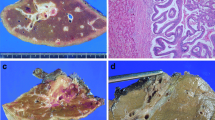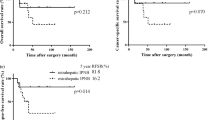Abstract
Background
To date, postoperative prognostic factors for intraductal papillary neoplasm of the bile duct (IPNB) have not been well-established. This study aimed to examine the histopathologic features and postoperative prognosis of the two IPNB subclassifications, as well as factors affecting prognosis, based on the authors’ experience at a single institution.
Methods
The study enrolled 83 patients who underwent surgical resection for pathologically diagnosed IPNB at the authors’ institution. The clinicopathologic features and postoperative outcomes for these patients were examined. The study also investigated postoperative prognostic factors for IPNB using uni- and multivariate analyses.
Results
More than half of the tumors (64%) diagnosed as IPNB were early-stage cancer (UICC Tis or T1). However, none were diagnosed as benign. The multivariate analysis showed that lymph node metastasis (hazard ratio [HR], 5.78; p = 0.002) and bile duct margin status with carcinoma in situ (D-CIS; HR, 5.10; p = 0.002) were independent prognostic factors, whereas MUC6 expression showed only a marginal influence on prediction of prognosis (HR, 0.32; p = 0.07). The tumor recurrence rate and the proportion of locoregional recurrence were significantly greater among the patients with D-CIS than among those with negative bile duct margins, including those patients with low-grade dysplasia. The patients with D-CIS showed a significantly poorer prognosis than those with negative bile duct margins (5-year survival, 38% versus 87%; p = 0.0002).
Conclusions
Evaluation of resected IPNBs showed cancer in all cases. Avoiding positive biliary stumps during surgery, including resection of carcinoma in situ, would improve the prognosis for patients with IPNB.




Similar content being viewed by others
References
Lokuhetty D, White VA, Watanabe R, Cree IA, World Health Organization, International Agency for Research on Cancer. Digestive system tumours. 5th ed. International Agency for Research on Cancer, Lyon, 2019.
Gordon-Weeks AN, Jones K, Harriss E, Smith A, Silva M. Systematic review and meta-analysis of current experience in treating IPNB: clinical and pathological correlates. Ann Surg. 2016;263:656–63.
Kloek JJ, van der Gaag NA, Erdogan D, et al. A comparative study of intraductal papillary neoplasia of the biliary tract and pancreas. Hum Pathol. 2011;42:824–32.
Rocha FG, Lee H, Katabi N, et al. Intraductal papillary neoplasm of the bile duct: a biliary equivalent to intraductal papillary mucinous neoplasm of the pancreas? Hepatology. 2012;56:1352–60.
Jung G, Park KM, Lee SS, Yu E, Hong SM, Kim J. Long-term clinical outcome of the surgically resected intraductal papillary neoplasm of the bile duct. J Hepatol. 2012;57:787–93.
Kang MJ, Jang JY, Lee KB, Han IW, Kim SW. Impact of macroscopic morphology, multifocality, and mucin secretion on survival outcome of intraductal papillary neoplasm of the bile duct. J Gastrointest Surg. 2013;17:931–8.
Bosman FT, World Health Organization, International Agency for Research on Cancer. WHO classification of tumours of the digestive system. 4th ed. International Agency for Research on Cancer, Lyon, 2010.
Nakanuma Y, Jang KT, Fukushima N, et al. A statement by the Japan-Korea expert pathologists for future clinicopathological and molecular analyses toward consensus building of intraductal papillary neoplasm of the bile duct through several opinions at the present stage. J Hepatobiliary Pancreat Sci. 2018;25:181–7.
Yang CY, Huang WJ, Tsai JH, et al. Targeted next-generation sequencing identifies distinct clinicopathologic and molecular entities of intraductal papillary neoplasms of the bile duct. Mod Pathol. 2019;32:1637–45.
Sobin LH, Gospodarowicz MK, Wittekind C, International Union Against Cancer. TNM classification of malignant tumours. 7th ed. Chichester, Hoboken: Ebrary Inc, Wiley-Blackwell, 2009.
Albores-Saavedra J, Henson DE, Sobin LH. WHO histological typing of tumors of the gallbladder and extrahepatic bile ducts. 2nd ed. Springer, Berlin, 1991.
Albores-Saavedra J, Henson DE. Tumors of the gallbladder, extrahepatic bile ducts, and ampulla of vater. Published by the Armed Forces Institute of Pathology under the auspices of Universities Assocaited for Research and Education in Pathology, Washington, D.C., 2000.
Zen Y, Fujii T, Itatsu K, et al. Biliary papillary tumors share pathological features with intraductal papillary mucinous neoplasm of the pancreas. Hepatology. 2006;44:1333–43.
Chen TC, Nakanuma Y, Zen Y, et al. Intraductal papillary neoplasia of the liver associated with hepatolithiasis. Hepatology. 2001;34(4 Pt 1):651–8.
Zen Y, Fujii T, Itatsu K, et al. Biliary cystic tumors with bile duct communication: a cystic variant of intraductal papillary neoplasm of the bile duct. Mod Pathol. 2006;19:1243–54.
Zen Y, Sasaki M, Fujii T, et al. Different expression patterns of mucin core proteins and cytokeratins during intrahepatic cholangiocarcinogenesis from biliary intraepithelial neoplasia and intraductal papillary neoplasm of the bile duct: an immunohistochemical study of 110 cases of hepatolithiasis. J Hepatol. 2006;44:350–8.
Yonezawa S, Nakamura A, Horinouchi M, Sato E. The expression of several types of mucin is related to the biological behavior of pancreatic neoplasms. J Hepatobiliary Pancreat Surg. 2002;9:328–41.
Pinto-de-Sousa J, David L, Reis CA, Gomes R, Silva L, Pimenta A. Mucins MUC1, MUC2, MUC5AC, and MUC6 expression in the evaluation of differentiation and clinico-biological behaviour of gastric carcinoma. Virchows Arch. 2002;440:304–10.
Nakanuma Y, Sato Y, Ojima H, et al. Clinicopathological characterization of so-called “cholangiocarcinoma with intraductal papillary growth” with respect to “intraductal papillary neoplasm of bile duct (IPNB).” Int J Clin Exp Pathol. 2014;7:3112–22.
Onoe S, Shimoyama Y, Ebata T, et al. Prognostic delineation of papillary cholangiocarcinoma based on the invasive proportion: a single-institution study with 184 patients. Surgery. 2014;155:280–91.
Tsukahara T, Ebata T, Shimoyama Y, et al. Residual carcinoma in situ at the ductal stump has a negative survival effect: an analysis of early-stage cholangiocarcinomas. Ann Surg. 2017;266:126–32.
Higuchi R, Yazawa T, Uemura S, Izumo W, Furukawa T, Yamamoto M. High-grade dysplasia/carcinoma in situ of the bile duct margin in patients with surgically resected node-negative perihilar cholangiocarcinoma is associated with poor survival: a retrospective study. J Hepatobiliary Pancreat Sci. 2017;24:456–65.
Wakai T, Shirai Y, Moroda T, Yokoyama N, Hatakeyama K. Impact of ductal resection margin status on long-term survival in patients undergoing resection for extrahepatic cholangiocarcinoma. Cancer. 2005;103:1210–6.
Higuchi R, Ota T, Araida T, Kobayashi M, Furukawa T, Yamamoto M. Prognostic relevance of ductal margins in operative resection of bile duct cancer. Surgery. 2010;148:7–14.
Kim WJ, Hwang S, Lee YJ, et al. Clinicopathological features and long-term outcomes of intraductal papillary neoplasms of the intrahepatic bile duct. J Gastrointest Surg. 2016;20:1368–75.
Kubota K, Nakanuma Y, Kondo F, et al. Clinicopathological features and prognosis of mucin-producing bile duct tumor and mucinous cystic tumor of the liver: a multi-institutional study by the Japan Biliary Association. J Hepatobiliary Pancreat Sci. 2014;21:176–85.
Bartman AE, Buisine MP, Aubert JP, et al. The MUC6 secretory mucin gene is expressed in a wide variety of epithelial tissues. J Pathol. 1998;186:398–405.
Furukawa T. Subtyping of IPMN. Methods Mol Biol. 2019;1882:1–8.
Thuwajit P, Chawengrattanachot W, Thuwajit C, Sripa B, Paupairoj A, Chau-In S. Enhanced expression of mucin 6 glycoprotein in cholangiocarcinoma tissue from patients in Thailand as a prognostic marker for survival. J Gastroenterol Hepatol. 2008;23:771–8.
Aishima S, Kuroda Y, Nishihara Y, et al. Gastric mucin phenotype defines tumour progression and prognosis of intrahepatic cholangiocarcinoma: gastric foveolar type is associated with aggressive tumour behaviour. Histopathology. 2006;49:35–44.
Harada F, Matsuyama R, Mori R, et al. Outcomes of surgery for 2010 WHO classification-based intraductal papillary neoplasm of the bile duct: case-control study of a single Japanese institution’s experience with special attention to mucin expression patterns. Eur J Surg Oncol. 2019;45:761–8.
Acknowledgments
The authors thank Editage (www.editage.jp) for English language editing. This work was funded by the JSPS KAKENHI, Grant No. 18K08632. The funding organization had no role in the study design; in the collection, analysis, or interpretation of data; in the writing of the report; or in the decision to submit the article for publication.
Author information
Authors and Affiliations
Corresponding author
Ethics declarations
Disclosure
There are no conflicts of interest.
Additional information
Publisher's Note
Springer Nature remains neutral with regard to jurisdictional claims in published maps and institutional affiliations.
Electronic supplementary material
Below is the link to the electronic supplementary material.
Rights and permissions
About this article
Cite this article
Uemura, S., Higuchi, R., Yazawa, T. et al. Prognostic Factors for Surgically Resected Intraductal Papillary Neoplasm of the Bile Duct: A Retrospective Cohort Study. Ann Surg Oncol 28, 826–834 (2021). https://doi.org/10.1245/s10434-020-08835-6
Received:
Accepted:
Published:
Issue Date:
DOI: https://doi.org/10.1245/s10434-020-08835-6




